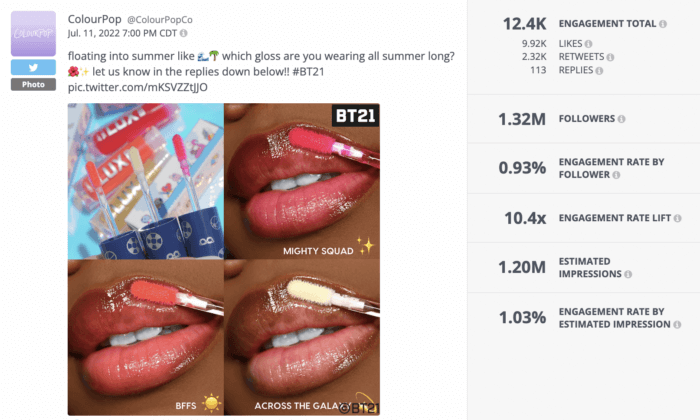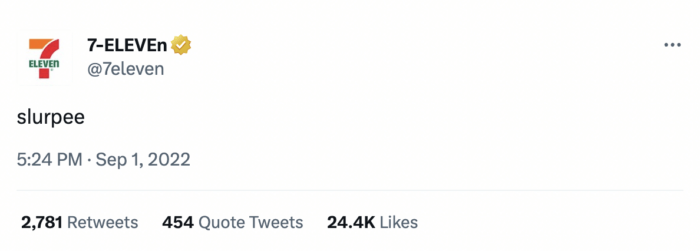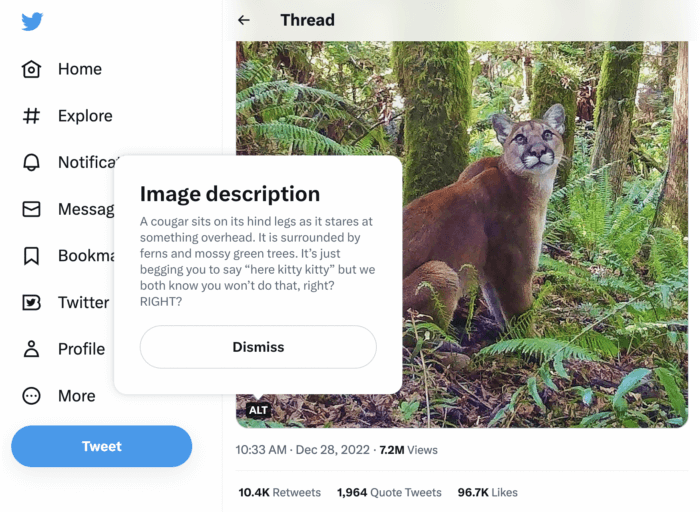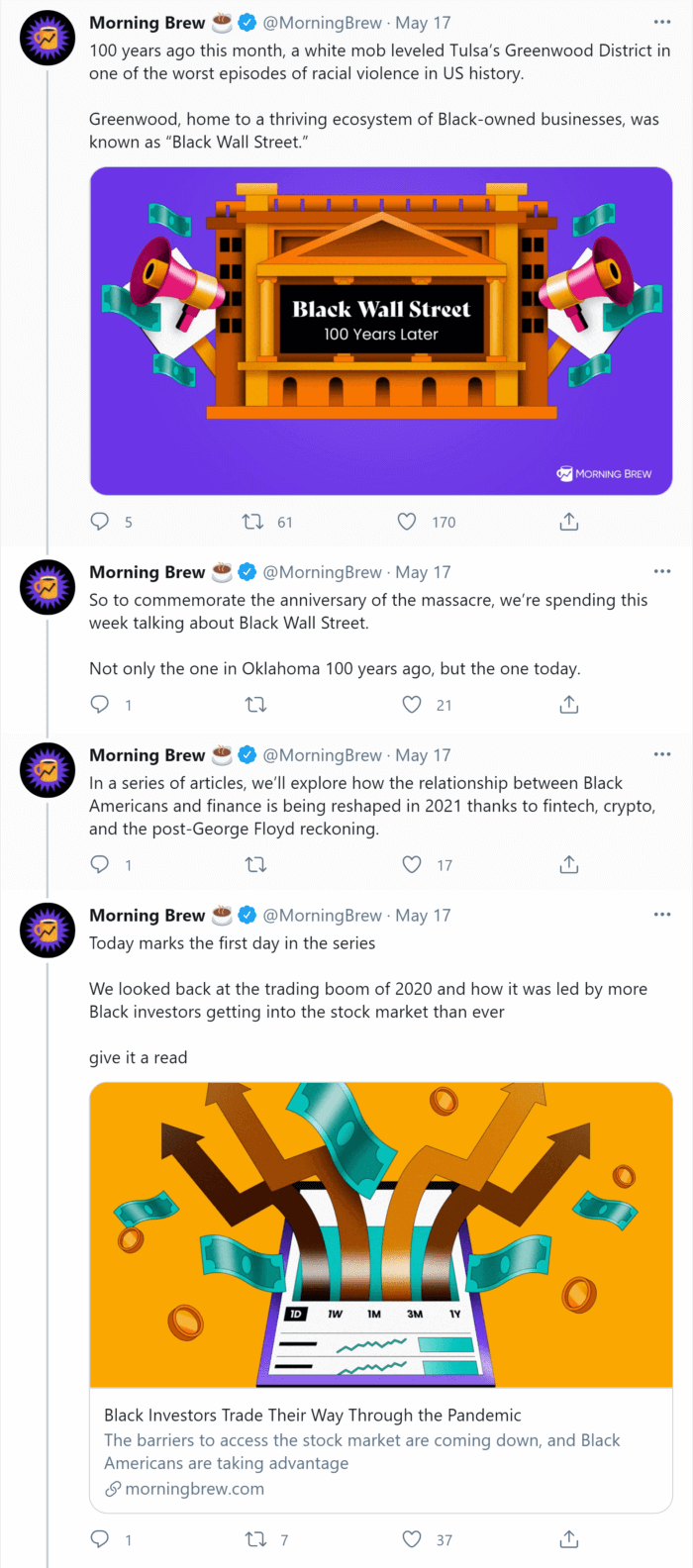From community-building to sparking conversations to participating in a viral trend, the best Twitter best practices give brands and followers the ability to connect 1:1.
But just like any other social platform, your Twitter strategy should be tailored to the way your audience consumes content here versus on Instagram or Facebook.
Whether starting conversations or tapping into ones that your followers are already having, there are a few Twitter best practices to follow if you really want your brand voice to shine and your content to perform well in the feed.
Below, we rounded up 10 Twitter best practices for 2023 and our favorite examples of them in action.
Engage and interact
Engagement is the name of the game on Twitter. On a social platform that’s all about connection and conversation, it only makes sense that one of the top Twitter best practices is to actually interact with your followers.
When it comes to engagement rates on Twitter, they’ve been pretty steady over the last year. The median engagement rate on Twitter is 0.035% across industries, according to our latest Social Media Industry Benchmark Report. To ensure that your content has the best chance of reaching the average engagement rate (or beyond), it’s essential to stay active and tapped into what your followers are interested in talking about.
You can encourage engagement on Twitter in numerous ways, whether that’s directly responding to someone’s tweet (if and when appropriate), prompting your audience to share stories or opinions, or asking questions.
One easy way to interact on your page is by asking your followers to reply to a tweet. This can be as a way to enter a giveaway, to ask for their thoughts on a product, or simply to encourage participation. Top beauty brand ColourPop followed this best practice when it asked its followers to reply to this tweet with their favorite lip gloss from the brand’s latest collection. This tweet generated an engagement rate that’s 26 times greater than the median, and it received 113 replies.

Establish a clear brand voice
It’s fair to say that Twitter popularized the personified brand when it comes to social strategy. From fast food chains to retail companies, when brands personify their accounts they take on the voice of an individual rather than a company in an effort to shake off their corporate image and reveal a more casual, human side.
While you don’t necessarily need to take the Wendy’s approach (though, if that’s a style that resonates with your audience, more power to you!), the fast food chain created the playbook for tweeting with a clear and recognizable voice.
Top convenience store brands like Kum & Go and Kwik Trip follow this strategy. The two stores get personal on Twitter, often roasting each other on the platform using distinct voices that their followers know and love. And this approach clearly works for them as both brands are top performers on Twitter when it comes to engagement.

Establishing a conversational or personified brand voice like this is a great way to connect with your followers on a more personal level. When brands use a tone that’s more casual or friendly, followers feel like they’re reading tweets from another person rather than a brand. A lighter, more casual tone can also liven up dry or technical content and allow it to stand out in the feed.
Hop on the trends
While your Twitter strategy shouldn’t be based solely on trends, it’s a good idea to incorporate them every now and again to boost engagement. Twitter is the source for some of the most viral trends, so it doesn’t hurt to join in on the fun as long as it’s relevant and executed in a way that resonates with your audience. Keep in mind that not every trend may work for your brand, so don’t force it if it doesn’t make sense.
One example of a trend that took over the feed last year comes from Amtrak. The railroad company tweeted a single word that set off hundreds of similar tweets from brands: trains.

Countless brands followed suit, sharing their own version of the one-word tweet by replacing “trains” with a word that best represents their business. Brands had to act fast to stay relevant, and many shared their own version within a couple of hours after the Amtrak tweet went live.

The key to successfully participating in a trend is finding a way to connect your brand to the conversation — and quickly. A Twitter trend can be old news within a day or two, so it’s important to be creative and get the necessary posting approvals as soon as possible.
While using trending memes and hashtags may sound like something only consumer brands can do, B2B brands on Twitter shouldn’t shy away from having a little fun with trends, too. As long as it’s appropriate and relevant, this type of content can be a fun way to engage with your audience and show a lighter side of the brand.
Have a plan for customer service
Because of the conversational nature of Twitter, it’s not uncommon for users to visit a brand’s page seeking answers to their questions about your product or service. Make sure you have a plan for how to respond if and when these questions and concerns come up, and maybe even have a dedicated team to direct them to (social media managers have enough on their plates as it is!).
You may even consider creating a separate account for customer inquiries that operates like a help desk and can be managed by your company’s customer service team as retail brand Kith does.

When it comes to managing customer service on Twitter, response time is critical. Make sure you respond promptly with either an answer to their question or a clear next step. Slow responses — or worse, no response at all — can make customers feel ignored and can ultimately affect their perception of your brand.
Make your content inclusive and accessible
Ensure everyone has access to your content by optimizing it for inclusivity and accessibility. One accessibility tip for your copy is to use title case when writing hashtags that contain more than one word. Capitalizing the first letter in each word makes it easier for screen readers to pronounce it correctly.
Another way to make sure your content is accessible is to add alt text to your images. Alt text is helpful for those who are deaf or hearing-impaired and use screen readers to understand the context of an image. Alt text should describe what the image depicts, and the more details you can provide the better. Also, keep in mind that your alt text doesn’t have to be boring.
In fact, the Twitter account for the Washington State Deptartment of Natural Resources offers a prime example of how to use alt text as another opportunity to engage your followers. The account includes descriptive yet entertaining alt text captions in every image it shares. Not only do these alt text descriptions make the account’s content inclusive to all followers, but they undoubtedly generate interest for being entertaining to read.

Get the most out of blog content through proper distribution
If you have a library of blog articles, then sharing that content on a regular basis should be part of your Twitter strategy. But don’t just post a link to the blog post and call it a day. To get the most out of the content and increase your click-through rate, tailor your copy for your Twitter audience.
Whether you write a short and quippy caption, highlight a key point or piece of data from the blog post, or pose a question, the copy should resonate with your audience in a way that will get them to stop scrolling and visit the blog post. If you want to go the extra mile, create a custom image that stands out in the feed.
Another creative way to share blog content on Twitter is by utilizing the thread method. This involves introducing the topic and then following up the initial thought with several more tweets, ultimately ending with a link to the blog post if users want to learn more. This method is popular among individual thought leaders and influencers, but media brand Morning Brew successfully demonstrates how it’s done in the example below.

Diversify your hashtags
Social media strategists know that a hashtag that performs well on Instagram might not carry the same weight on Twitter. Before you copy and paste the hashtags from your latest Instagram post into an upcoming tweet, do your research to see which hashtags have high engagement and impression rates on Twitter.
If you have a Rival IQ account, you can access our hashtag analytics tool that shows which hashtags brands in your industry are using. The tool also provides insights into the engagement rate and usage of these popular hashtags so you can better understand which ones are worth including in your next tweet.

You can also keep an eye on which hashtags are currently trending on Twitter and review those to see if any of them are relevant to your brand.
Pro tip: Twitter recommends limiting your hashtags to no more than two per tweet to keep your message concise.
Don’t forget about strong visuals
While captivating copy is essential on a conversation-driven platform like Twitter, strong visuals are just as important. In a feed full of text, visuals grab people’s attention in a way that words sometimes can’t, so if you want to get users to stop scrolling and pay attention to what you’re saying, then your content needs to include eye-catching visual elements — at least every once in a while.
This image shared by James Madison University, a top-performing school on social media, is undeniably visual. Not only does the vibrant sky stand out, but it also aligns with the school’s colors, creating consistency across the brand’s content.

Aside from images, consider what other content your audience engages with most. For example, animated visuals like GIFs and videos generated higher engagement rates than static images for schools and universities on Twitter, according to our post types analysis.

Twitter image sizes
Twitter has its own specs for image sizes, so it’s a quick best practice to remember is to create unique images for the platform rather than reposting the same images you used on Instagram or Facebook.
Below are a few standard image sizes to keep in mind for Twitter.
Profile image: 400 x 400 pixels
Header image: 1500 x 500 pixels
In-stream image: Single images are displayed at a 16:9 ratio of 600px by 335px, and can expand to 1200 x 675 pixels when clicked on
Experiment with new Twitter features
Twitter is always evolving and rolling out new features (RIP, Fleets). When these features pop up, don’t be afraid to experiment with new types of content. While you don’t yet know how your audience will respond, these features could unlock new avenues for engagement and community building, making them worth exploring.
For example, one of Twitter’s most recent additions to the platform is Spaces. Twitter Spaces is a live audio feature is meant to drive conversation beyond tweets. Brands use Spaces to host AMA sessions or curated panels to better connect with their community and spark a two-way conversation. If your audience tends to respond well to Q&A content, then Spaces may be worth exploring.
Plus, Spaces are housed in their own tab (Spaces can only be accessed on mobile) which helps with discovery and reach. In the dedicated tab, users can explore Spaces that are happening in real-time or browse upcoming conversations they may be interested in.

Before you dive into the latest trend, keep in mind that not every new feature may work for your brand. Determine how much time and energy you’re willing to invest in experimenting with a new feature. Something like Spaces requires more planning and execution than putting together a thread, so it’s important to do your research and get an idea of how well your content would perform before you go all in. Afterward, monitor your analytics to see how it fared compared to your average rates in terms of impressions and engagement.
Engage in social listening
Social listening has become an essential practice for brand marketers across all industries. Whether to monitor what people are saying about your brand or keep an eye on what’s being said about the competition, social listening is all about making sure you’re tapped into what’s going on around you, even if you’re not directly mentioned.
In the tweet below, UT Knoxville jumped on the opportunity to reply to this tweet from French’s that mentioned the color orange — the school’s primary color.

To follow this Twitter best practice, use a social listening tool to track indirect mentions of your brand, your competitor’s brand, or conversations happening around your industry by plugging in specific keywords or brand names. Doing this will not only help you stay on top of industry trends and monitor the competition, but it will allow you to better understand what your customer is interested in or what their current gripes are.
You can use Rival IQ’s social listening tool to track certain keywords or keep an eye on brand mentions to see what types of conversations people are having within your industry.
Start social listening with Rival IQ. 
Wrapping it up
There are always new Twitter best practices to incorporate into your social media strategy. And fortunately, it’s a fun platform to experiment with. Whether you want to explore using more videos or try out a new feature, just be sure to measure the results after incorporating any of these Twitter best practices.
As long as you have a social media analytics tool to see how your content performed, you can take the data into account, adjust accordingly, and give it another try or make it a regular part of your Twitter strategy.
This post was originally published in June 2021 and has since been updated.
